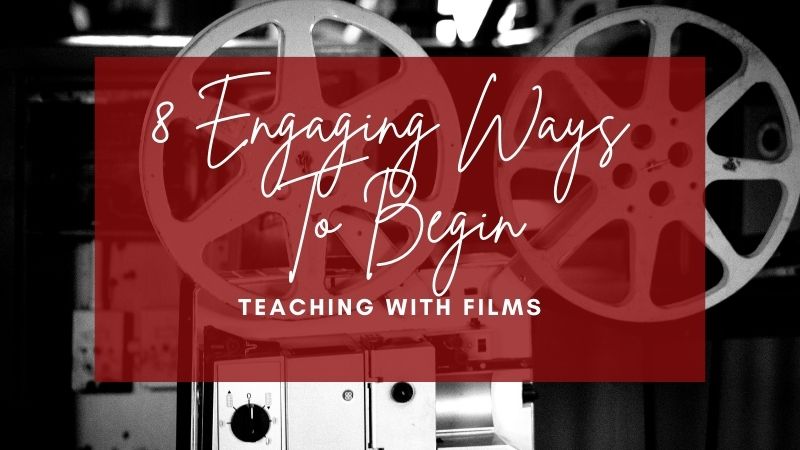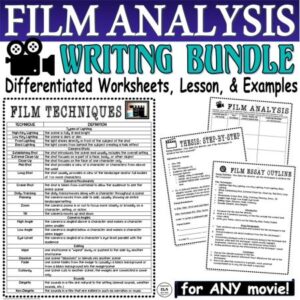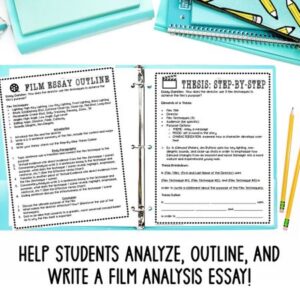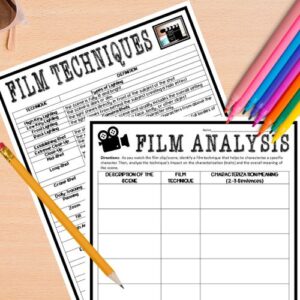Teaching with films can be a highly controversial activity in education. Even though people nowadays consume more movies and videos than any other form of media, we rarely consider them valid forms of literature. And this perception is unfortunate.
So many of us watch hours of movies without really thinking. And guess what? Our students do as well.
Instead of avoiding all forms of media, why not include them within our curriculum throughout the year? You don’t have to show students a whole movie, but teaching with films can be powerful in so many ways!
Keep reading for ways to begin teaching with films that will make your job and your students’ learning MUCH more fun, thought-provoking, and productive!
Need help with Test Prep? Check out this FREE Pack of 3 Test Prep Activities to help students achieve success on standardized tests!

10 Ways to Begin Teaching with Films
1. Teach Comprehension Skills
Starting with comprehension skills may be the easiest for students. We want our students to be able to comprehend what they are watching as well as what they are reading. Sometimes, our students don’t see these skills as connected, but they really are.
You can focus on the following standards while teaching with films:
- Main Idea-What is the central concept(s) being discussed throughout the film?
- Structure-What is the order of events?
- Words/Phrases-What dialect is being used by the characters and why?
- Purpose-What prompted the director to create this movie?
- Citing Evidence-What details are important to the story’s message?
- Characterization-What characters are shown in the film and why?
Providing questions before, during, and after reading is so important in helping students truly understand what they are watching. And you can vary the questions to help your students with differentiation!
Lower-Level Questions:
- What is going on in this scene?
- What are some traits you notice about the characters?
- What is the setting of the clip?
Middle-Level Questions:
- How does the mood change?
- How does a character and/or person change?
- Why might the music and/or sound change?
Higher-Level Questions:
- What is the theme and/or message of the story?
- Why is this scene important in this film?
- What might the audience learn as a result of this clip?
By having your students actually THINK as they watch, they will hopefully see that movies are not simply a mindless form of entertainment.
2. Teach Film Techniques
As you start teaching with films, you might want to consider introducing students to film techniques. Directors use various techniques across many genres of films, so recognizing them is step number one. And once students begin noticing these techniques, they will never view a movie or video in the same way again!
Steps to teaching with films through techniques:
- Define the technique.
- Provide an example through a film clip.
- Examine why the technique might be used.
Here is a bundle with a list of techniques you could use to begin teaching with films!
3. Teach Critical Thinking
When introducing movies as a valid media form, you will definitely want to add critical thinking elements through questioning, writing, and discussion.
3 Questioning, Writing, & Discussion Steps:
- Provide question stems to get students thinking.
- Why might the director…
- What might change if the actor…
- How does the sound…
- What theme…
- What words or phrases convey that…
- Let students respond to their own questions first in quickwrites.
- Encourage students to present and discuss their questions based on the film in pairs, small groups, or Socratic Seminars.
Ultimately, we want our students to continually work to examine what they are “feeding” themselves on a daily basis. Like food, we need to consider and then include “healthy” options and not consume what others merely say is good for our bodies!
4. Teach Rhetorical Appeals
If you are in the middle of an argument unit, teaching with films that include rhetorical appeals could help your students see an argument in action! Consider speeches from various movies that incorporate logos, pathos, and ethos!
- Logos is an appeal to the audience’s rational thought by using facts and statistics.
- Pathos is an appeal to the audience’s emotions through the use of emotional language.
- Ethos is an appeal to the audience through a belief in the speaker’s authority or credibility.
My favorite film to teach these appeals is 12 Angry Men. When Henry Fonda’s character presents the facts and the facts alone as indicators of the boy’s innocence, he is appealing to the jurors’ sense of logic. They ultimately cannot escape the facts of the situation. In contrast, the juror who holds out until the very end is driven entirely by pathos. He cannot see beyond his feelings.
By teaching with a focus on these rhetorical appeals, you can help your students start their journeys into writing rhetorical analysis!

5. Teach Genres
Ultimately, we each have genres that appeal to us. I may prefer historical romances, science fiction, and fantasy films. Our students, in contrast, may like other genres, and that is okay.
Film Genres:
- Romance
- Action
- Adventure
- Thriller
- Mystery
- Documentary
- Comedy
- Drama
- Horror
- Science Fiction
- Fantasy
And the list goes on! There are plenty of appropriate film clips out there that you can use to teach genre. Taking the time to view these genres and discuss the characteristics of each will help your students better comprehend various texts in the future!
Introducing films with this activity might be a fun start to exploring genres as you begin teaching with films!
6. Teach Elements of Stories
If your students need help with examining short story elements, you may want to begin with a short film. Going step by step through a 10-20 minute video that relays a story will help engage your students as they actually get to see examples with their own eyes.
Short Story Elements:
- Setting- the description of time and place
- Protagonist- the main character(s) in the story
- Antagonist- the main opposing character(s) in the story
- Types of Conflict- the struggles or issues the protagonist experiences
- Plot- the major events in the story
- Exposition- an introduction to the characters, setting, and conflict
- Rising Action- the events leading to the climax of the story
- Climax- the most important event that helps to change a character and/or characters in some way
- Falling Action- the events leading to the story’s resolution
- Resolution- the end of the story
Every part might be initially evident and some elements may be debatable. As long as students use examples and reasoning to support their ideas, you should be good to go!
Want some ideas for teaching short stories? Click below!
7. Teach within Thematic Units
If you are teaching a unit on dystopian fiction, you may want to include teaching with films as a part of this thematic unit. Let’s say your students are reading The Hunger Games, “The Veldt,” “The Pedestrian,” and “The Unknown Citizen,” you could include thematically linked film clips from Gattaca, The Hunger Games movies, and Wall-E.
Each film focuses in some way on power dynamics, the perversion of technology, the future, etc. Having students examine the major themes in the films and how they link to each other will help students make connections they might not initially see.
Here is a thematic statement template you could use if you want your students to write an essay examining the theme in connection to dystopian literature:
In (Text Title) and (Text Title), (author) uses (_____________ elements) to portray that (Theme or Themes).
9. Teach Literary Analysis
I love to teach literary analysis, and usually, I try to get students to focus on one of three elements: mood, characterization, and theme.
MOOD
When you are working with struggling readers, you might want to have students start their literary analysis by examining mood. Identifying the emotion created by a specific scene can be a wonderful first step.
As the scene/film changes, encourage your students to describe how the mood changes and why.
CHARACTERIZATION
Characterization is developed usually over the course of a text and/or film. There are many characters who are flat (1 or 2 character traits) and some who are round (many character traits). If you begin teaching with films, your students will gradually see that good movies usually incorporate both.
Then, we have characters who are static (unchanging) and dynamic (changes in some way). Traditionally, the protagonist changes, BUT it is fun to see an antagonist change as well!
Helping students to identify the traits, how they change, and why they change over time is the next level our students need to reach in literary analysis.
THEME
Lastly, we have a theme. A theme is a message or lesson learned in a text or movie. This concept can be difficult for students to understand as it requires a much higher level of critical thinking. You could examine multiple elements connected to themes as you start teaching with films!
- Film techniques
- Mood
- Characterization
- Scenes
- Short Story Elements
How does one of the above concepts contribute to the theme of the film and/or film? Why does the director include the element and why? What is the purpose or theme created by this technique?
Overall, to get our students to higher-level thinking, we need to push them to see beyond the minute details. We want them to understand why certain techniques, scenes, characters, etc. exist!
Click below to get this film analysis writing bundle, so you can easily teach film analysis from start to finish!
Why is teaching with films important in EVERY classroom?
- Our students must be able to think about what others offer them no matter the format.
- Our students must learn how to dissect the meaning beyond the initial presentation.
- Our students must be prepared for a future that is geared more and more toward the visual.
- Our students must meet the standards related to media.
- Our students must understand how they could be manipulated or convinced.
Clearly, teaching with films is not an option but a NECESSITY!
Have more questions about teaching with films? Check out this post below!
Need more fun lessons and activities for teaching with films? Check out my store Kristin Menke-Integrated ELA Test Prep!







